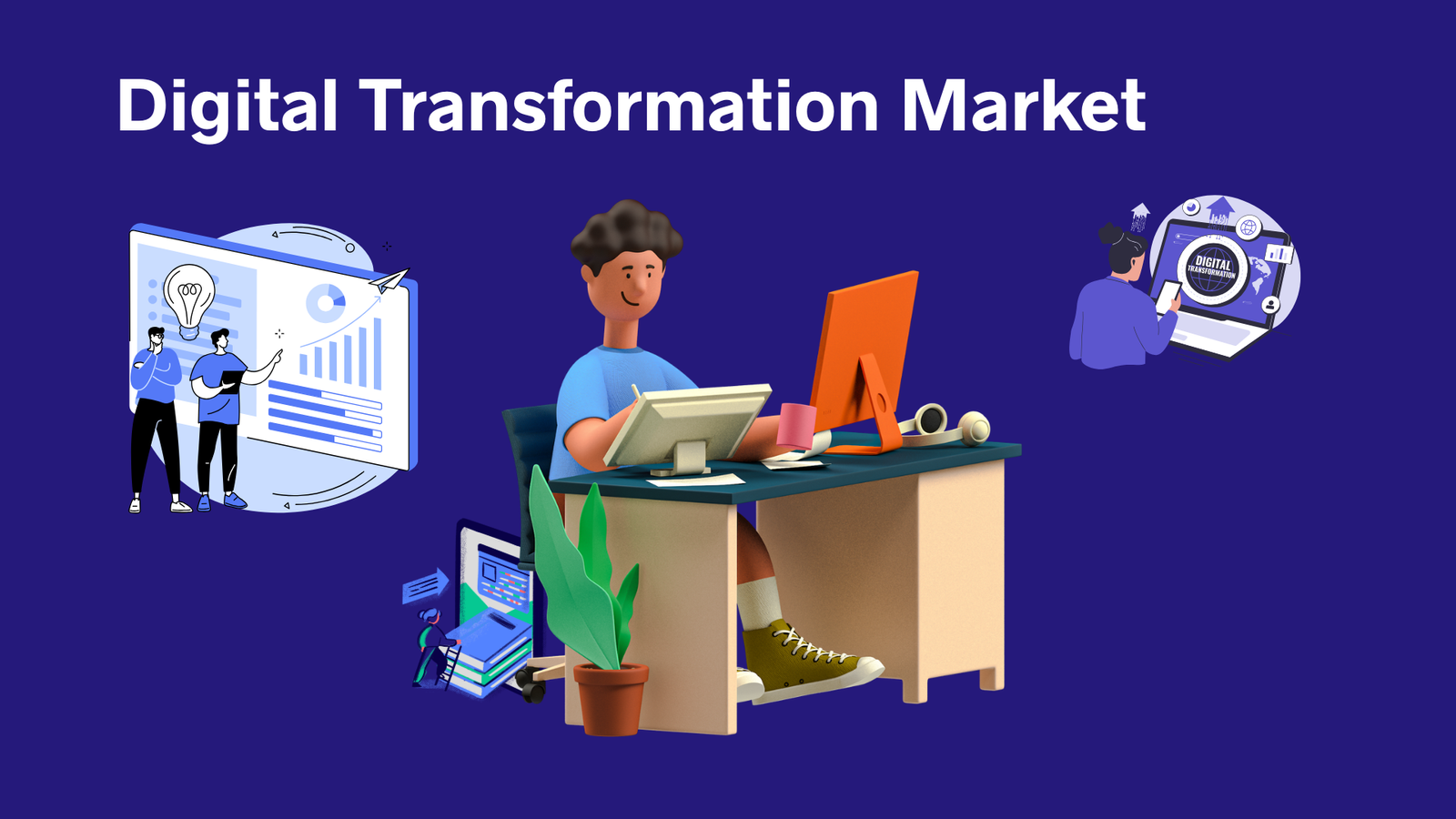Digital Transformation Market Surges Toward USD 8,567.4 bn 2033
Updated · Sep 17, 2025

WHAT WE HAVE ON THIS PAGE
Introduction
The global Digital Transformation Market was valued at USD 829.5 billion in 2023 and is projected to reach nearly USD 8,567.4 billion by 2033. This represents a remarkable CAGR of 26.3% during the forecast period from 2024 to 2033, reflecting the accelerating adoption of advanced digital technologies across industries.
The Digital Transformation Market refers to the adoption of digital technologies by organizations to improve operations, enhance customer experiences, and create new business models. It covers cloud computing, artificial intelligence, big data analytics, internet of things (IoT), robotic process automation (RPA), blockchain, and advanced connectivity. Digital transformation is applied across industries such as banking, healthcare, retail, manufacturing, and government to modernize legacy systems, increase agility, and improve competitiveness in a rapidly evolving digital economy.
The market is driven by the growing need for operational efficiency, customer-centric services, and innovation in business models. Rising competition and changing consumer expectations are pushing organizations to adopt digital strategies. The expansion of e-commerce, digital payments, and mobile-first services is further supporting transformation efforts. The availability of cloud infrastructure and advancements in AI and automation are enabling businesses to scale digital initiatives quickly. Additionally, government policies promoting digital economies are contributing to growth.

Key Takeaways
- The Global Digital Transformation Market is projected to reach USD 8,567.4 billion by 2033, growing at a strong CAGR of 26.3% from 2024 to 2033.
- Adoption of AI, cloud computing, and IoT is driving efficiency, cost reduction, and productivity gains, fueling rapid growth.
- By 2023, digitally transformed entities contributed over 50% of global GDP, underscoring their critical role in global economic activity.
- By component, Solutions dominated with 69.7% share in 2023, reflecting demand for digital business platforms.
- By deployment mode, On-premise solutions held 63.9% share, preferred for security and customization.
- By technology, Big Data & Analytics led with 30.1% share, supported by rising data volumes across industries.
- By enterprise size, Large Enterprises captured 61.5% share, leveraging resources for global-scale digital strategies.
- By end-use, the BFSI sector accounted for 27.4% share, driven by customer experience improvements and compliance needs.
- Regionally, North America led with 41.9% share in 2023, supported by advanced infrastructure and early adoption of digital technologies.
Role of Generative AI
Generative AI is playing a crucial role in digital transformation by enabling businesses to create new content and automate complex tasks, which helps speed up innovation and improves operational efficiency. Around 36% of organizations are expected to integrate generative AI tools in their operations within the next year, with 29% already piloting these technologies, showing strong signs of adoption.
This technology supports a wide range of activities from personalized marketing content creation to software development assistance, saving time and reducing errors. By enhancing decision-making and delivering personalized experiences at scale, generative AI is fundamentally reshaping how companies approach digital change, pushing industries toward faster and more creative solutions.
Emerging Trends
In 2025, digital transformation trends focus heavily on AI-driven automation, especially with AI agents and machine learning automating complex workflows to reduce time and costs by almost 40-50%. Industry-specific applications have surged, with sectors like healthcare employing AI for diagnostics and personalized treatment, financial services using AI for fraud detection, and retail integrating AI for dynamic pricing and improved user experience.
The rise of hybrid cloud ecosystems and digital sustainability are also shaping transformation efforts. Organizations are increasingly adopting modular and scalable technology to remain agile, while tools like hyperautomation combine RPA, AI, and ML to automate entire workflows, yielding efficiency improvements throughout business processes.
Growth Factors
The primary growth drivers for digital transformation include operational efficiency gains, faster time-to-market for products and services, and improvements in customer experience, each contributing significantly to digital initiatives. Around 40% of digital projects are motivated by the desire to boost operational efficiency, with 36% aiming to shorten delivery cycles and 35% enhancing how customers interact with services.
Cloud computing remains foundational, offering flexibility and scalability needed to adapt quickly to market changes. Talent development and strategic planning also play critical roles, ensuring organizations have the right skills and clear goals to execute digital transformation effectively.
Driver Analysis
Growing Customer Expectations
One significant driver of digital transformation is the rising expectations of customers for faster, more personalized, and convenient services. With widespread use of smartphones and online platforms, customers now expect businesses to provide seamless digital experiences, whether in retail, banking, or healthcare. For instance, companies that offer personalized recommendations or instant online support tend to meet modern consumer needs better and stay ahead of the competition.
Meeting these customer expectations pushes organizations to adopt digital tools that improve user experience and engagement. Businesses increasingly invest in technologies like artificial intelligence to analyze data and tailor their services. This digital shift not only satisfies customers but also helps companies grow by attracting and retaining loyal users who prefer digital interactions.
Restraint Analysis
High Costs and ROI Uncertainty
A major restraint to digital transformation is the high upfront investment required and the difficulty in showing clear returns on investment. Many organizations face costly infrastructure upgrades, software implementation, and staff training, which can strain budgets. For example, without well-defined performance metrics, digital projects may appear expensive experiments with underwhelming financial results.
Additionally, only a portion of companies effectively measure the success of their digital initiatives, which makes justifying further spending harder. Challenges such as resistance to change and legacy technologies complicate achieving expected benefits, causing some businesses to hesitate before fully committing to transformation efforts. Careful planning and phased investments are essential to overcome these hurdles.
Opportunity Analysis
Expansion through AI and Automation
Digital transformation offers a substantial opportunity to enhance business efficiency and create new growth paths through artificial intelligence and automation. By leveraging AI, companies can automate routine tasks, improve decision-making, and deliver customized customer experiences. For instance, AI-powered automation in manufacturing can reduce downtime by predicting equipment failures, thus increasing productivity.
Furthermore, businesses can discover new revenue streams by deploying intelligent systems that analyze vast amounts of data quickly. This capability allows organizations to reach untapped markets, optimize operations, and innovate faster than ever. Embracing AI-driven digital transformation can significantly boost competitiveness and pave the way for long-term success.
Challenge Analysis
Managing Cybersecurity Risks
One of the pressing challenges in digital transformation is managing the increased cybersecurity risks that come with expanding digital footprints. As companies adopt more connected devices, cloud services, and remote work setups, their exposure to cyber-attacks grows substantially. For instance, sectors like banking and healthcare face serious threats from ransomware and data breaches, which can erode customer trust and cause financial losses.
Organizations must balance innovation with strong security measures, requiring investments in advanced cybersecurity tools and continuous monitoring. Neglecting these risks can result in costly incidents that disrupt business operations and damage reputations. Effective cybersecurity management is thus critical for sustaining digital transformation efforts and protecting sensitive information.
Key Market Segments
Component
- Solution
- Services
Deployment Mode
- Cloud-Based
- On-Premise
Technology
- Big Data & Analytics
- Cloud Computing
- Cybersecurity
- Artificial Intelligence (AI)
- Blockchain
- Internet of Things (IoT)
- Other Technologies
Enterprise Size
- Small and Medium-Sized Enterprises
- Large Enterprises
End-Use Industry
- IT & Telecommunications
- BFSI
- Government & Public Sector
- Healthcare
- Manufacturing
- Retail
- Other End-Use Industries
Top Key Players in the Digital Transformation Market
- IBM Corporation
- Microsoft Corporation
- Amazon Web Services, Inc.
- Google LLC
- SAP SE
- Cisco Systems, Inc.
- Salesforce, Inc.
- Oracle Corporation
- Tata Consultancy Services Limited
- Accenture Plc
- Adobe Inc.
- Dell Inc.
- Hewlett Packard Enterprise
- Other Key Players
Sources

Barry loves technology and enjoys researching different tech topics in detail. He collects important statistics and facts to help others. Barry is especially interested in understanding software and writing content that shows its benefits. In his free time, he likes to try out new healthy recipes, practice yoga, meditate, or take nature walks with his child.










